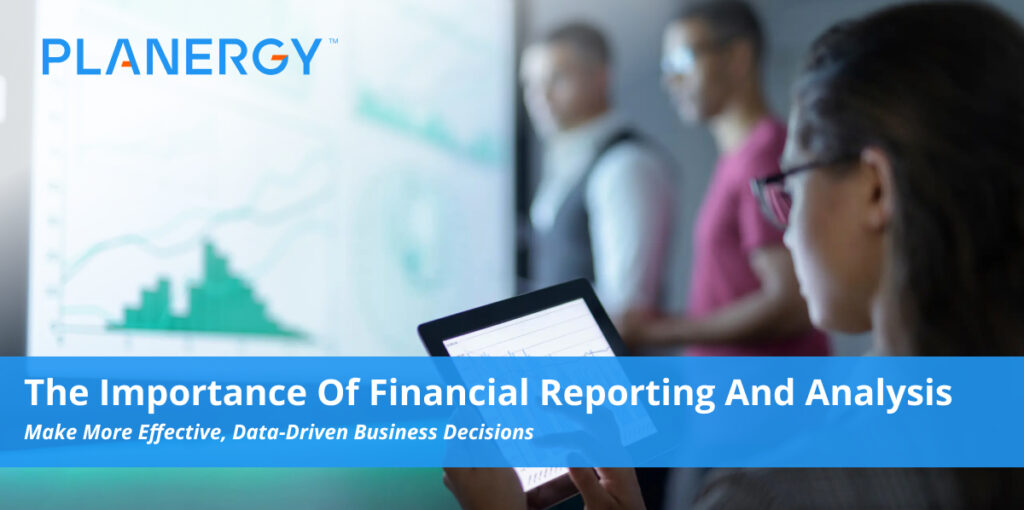Whether you’re a small business owner, a freelancer, or part of a team working at enterprise level, you’ve most likely come to appreciate the importance of financial reporting and analysis in building a successful business.
Financial reporting is, of course, required for most businesses, but analysis has also become an essential for any company that wants to compete effectively in today’s data-driven economy.
Accurate and proactive financial reporting and analysis can make a big difference in your company’s financial performance. And by understanding their importance and investing in the digital tools that can help you perform them with maximum effectiveness, you can extract the insights that will help you make better business decisions.
What is Financial Reporting and Analysis?
In order to evaluate a company’s performance and take action to help it grow, innovate, and compete effectively, stakeholders such as investors, creditors, and potential partners need a complete and transparent view of that company’s financial position.
Accurate records of company revenue and expenses, working capital/cash flow, and profits are critical in providing the insights needed to make strategic and intelligent business decisions.
In addition, financial reporting standards such as the generally accepted accounting principles, or GAAP (in the US) and the International Financial Reporting Standards, or IFRS (worldwide) require companies to use these records in preparing income statements and other financial information, as well as documenting the company’s operating activities. Income tax laws also require such reporting and documentation.
Financial analysis is used to evaluate the company’s financial information, via metrics known as key performance indicators, or KPIs. Metrics like these are used throughout companies to evaluate and improve performance, but in financial accounting they are used to determine a company’s overall financial health.
Using financial reporting software equipped with business intelligence and data analysis tools, financial professionals can harvest actionable insights from a company’s financial statements in time to use them effectively.
The most commonly financial statements generated using analysis include:
- Income statements, which compare revenue generated to expenses paid to measure profitability within a specific period of time (usually the fiscal year).
- Balance sheets, used to compare assets and liabilities. Balance sheets provide useful thumbnails of your company’s overall return on assets, owners’ equity (or shareholders’ equity), return on equity, working capital ratio, and debt-equity ratios, but don’t show the whole picture and are best reviewed in concert with other metrics to provide maximum strategic value.
- Cash flow statements, which document the amount of money flowing into and out of your company for a given period of time. This financial report is especially critical given the importance of proper cash flow management in meeting your outstanding obligations, making strategic investments, and minimizing risk to protect business continuity in emergencies.
- Financial performance dashboards, accessed via a financial software solution, provide dynamic and real-time financial reporting. Drawing from a diverse set of sources via a centralized data management platform, these dashboards allow users to create custom charts, graphs, and tables that can be used to examine working capital, track the cash conversion cycle, track vendor payment error rates, perform advanced asset valuation, and more.
These dashboards are designed to give users an intuitive and accessible way to sift through their financial data for insights they can use to improve their business processes, ensure optimal working capital, and create the most accurate budgets and forecasts possible. - Chief Financial Officer (CFO) dashboards, a type of specialized dashboard that provides high-level insights and trend data for senior decision-makers. These dashboards are used to connect financial performance to organizational goals. It also helps financial leaders analyze “soft value” metrics such as employee satisfaction.
Using financial reporting software equipped with business intelligence and data analysis tools, financial professionals can harvest actionable insights from a company’s financial data in time to use them effectively.
Clean and Complete Data Generates Optimal Financial Statements
To fully realize the benefits of your financial reports, you need full control over, and visibility into, your financial data.
Regardless of your goals and benchmarks, it pays to invest in a complete software solution that centralizes your data management, integrates all of your applications, and optimizes your processes to eliminate wasted time and resources.
Full data transparency destroys data silos, enhances communication and collaboration, and reduces risk by preventing common financial headaches such as rogue spend and invoice fraud.
A best-in-class procure-to-pay (P2P) solution like PLANERGY gives you access to not only advanced data analytics, custom dashboards, and real-time spend management, but robotic process automation powered by machine learning.
It’s cloud-based, mobile-friendly, and designed to support a wide array of both existing and custom software integrations, so you can enrich your data stream with diverse sources that add invaluable context to your analyses and provide even more strategic value.
Ultimately, your financial analyses are only as useful as the data used to create them.
By implementing a comprehensive, cloud-based P2P solution, you’ll be able to access all your data from all your sources, analyze it in real time, and make more strategic business decisions with confidence.
Key Benefits of Effective Financial Statement Analysis
Want to optimize your workflows to strengthen your company’s performance in a crowded marketplace? Cut your debts, strengthen your credit rating, and improve your cash flow?
What about making faster, more strategically valuable business decisions while improving your compliance?
Effective financial reporting and accounting, supported by best-in-class data management and analysis tools, can make it happen.
1. Real-Time Analyses
With current and historical spend and performance data at your fingertips, financial analysis can help you generate forecasts, reports, and data models to make informed, strategic decisions quickly—not hastily.
With real-time visibility and analysis, you can stay ahead of the competition and take swift advantage of opportunities for growth and investment that might otherwise pass you by.
2. Better Debt Management
Managing debts effectively is a priority for any business that wants to enjoy a long life. Transparency into debt-related data immensely improves your ability to manage it, and it’s not just corporations looking to tap into the power of financial reporting and analysis.
The United Nations, for example, has invested heavily in optimizing its data management and enhancing its analytics toolkit in recent years as a hedge against a growing global debt crisis.
Accurately tracking and analyzing the ratio between your current assets and current liabilities, as well as the financial processes related to generating revenue and paying your bills (i.e., accounts receivable and accounts payable), makes it easier to maintain short-term liquidity, plan long-term debt management, and adjust workflows and processes to ensure you’re getting the best possible return on every dollar when paying down debts.
3. Optimizing Financial Performance and Compliance
The insights you glean from analyzing your financial data have immediate value for strategic planning and decision-making. But those insights also generate long-term value by helping you identify opportunities to refine your processes, boosting efficiency, accuracy, and speed over time.
Even more importantly, complete and accurate financial data helps ensure complete and accurate financial statements that are fully compliant with all income tax law and financial reporting standards such as GAAP and IFRS, along with investor protection laws such as Sarbanes-Oxley and more recent data security standards such as the general data protection regulation (GDPR).
Meeting your tax obligations is easier, too. Accurate and complete financial accounting and reports simplify the tax process and also take much of the pain out of the auditing and valuation processes by providing step-by-step, transparent data trails.
4. Cash Flow Management
An estimated 82% of all small businesses fail due to cash flow problems. But businesses of all sizes are susceptible to cash flow challenges and unexpected market disruptions.
A 2020 study conducted by the International Labor Organization (ILO) found that, for businesses trying to navigate the COVID-19 novel coronavirus pandemic, cash flow management was the number one threat to business operations and solvency.
By carefully reviewing your KPIs, you can dive deeper into your revenue streams and liabilities to identify your current and future cash flow, create strategies to insulate against unpleasant surprises, and make sure you’ve got the capital on hand to take advantage of opportunities when they arise.
5. Improved Communication and Collaboration
On-demand, role-appropriate access to complete and clean financial data opens up a lot of new doors for sharing information, strategic planning, and building strong relationships with creditors, investors, and potential partners.
Real-time data analysis and sharing improves your company’s agility by putting everyone on the same page and allowing teams to hit the ground running.
For investors and creditors, a custom dashboard that documents key financial ratios such as debt-equity ratio, return on assets, P/E ratio, working capital ratio, current ratio, quick ratio, etc. makes it clear your company is committed to transparency, accuracy, and compliance—an attractive combination when you’re attempting to secure new funds, finance new product development, etc.
6. Reducing Risk Exposure
Mitigating risk is as important to your company’s financial health as process optimization and data quality, if not more so.
Financial analysis can help you reduce risk in several important ways:
- Identifying and correcting delays, inefficiencies, and errors in your financial processes before they become crises. Over time, and with the use of artificial intelligence and process automation, iterative improvements can refine processes to improve performance and accuracy even further.
- Using predictive analytics to anticipate changes in market conditions, supply chain disruptions, etc. and develop contingencies accordingly.
- Leverage data-driven insights to make more strategically sound business decisions, investments, and business process management initiatives organization-wide.
- Mitigating the risk of financial fraud by improving data security and spend management.
Some of the most important KPIs to track when you’re looking to mitigate risk include, but are not limited to:
- Cash Conversion Cycle Time
- Return on Assets
- Return on Equity
- Operating Expenses Ratio
- Gross Profit Margin
- Net Profit Margin
- Working Capital
7. Improving Supplier Relationship Management
Paying your bills on time (or even early) is a good way to become your vendors’ favorite customer.
But paying early to capture vendor discounts isn’t always the right choice for your cash flow management; sometimes, it might be smarter to pay as close to the due date as possible to preserve liquidity, or even request delayed payment if you have a strong relationship with your supplier.
Those relationships don’t just happen by themselves, however. Building a solid reputation with suppliers—and being able to take advantage of special incentives such as early payment discounts—is simpler when you use financial metrics to manage your spend.
Tracking your vendor payment error rate, for example, can help you pay the right amount at the right time for a healthy cash flow while preserving good will between you and your suppliers.
And don’t forget, choosing a comprehensive P2P solution will allow you to integrate your vendors’ systems directly to support electronic invoicing, vendor catalogs, and automated performance and compliance tracking.
The more data you have, the more effectively you can focus on building strong supplier relationships, add resiliency to your supply chain, and identify opportunities to partner with key suppliers to develop new products, improve your sustainable sourcing, or leverage economies of scale—all of which can give a significant boost to your company’s competitive performance and financial health over time.
Unlock Strategic Value with Effective Financial Reporting and Analysis
Data is one of the most valuable renewable resources at your company’s disposal—make sure you’ve invested in the right tools and are monitoring the right metrics.
You’ll reap strategic value and improve profitability while improving operating performance, ensuring optimal compliance with tax law and financial reporting and accounting standards, and providing stakeholders with the information they need to invest in your success.




